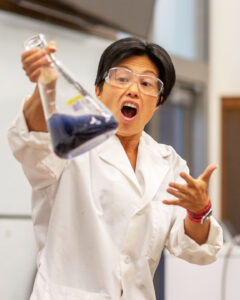Distinguished Alumnus

Clifton Gregory Sanders
The University of Utah Department of Chemistry alum Clifton Sanders will receive one of the Founders Day Distinguished Alumnus/Alumna Award on March 1, 2023.
The University of Utah, Office of Alumni Relations, annually presents its Founders Day Distinguished Alumnus/Alumna Awards to alums for their outstanding professional achievements, public service, and/or commitment to the U. Read more about the 2023 Founders Day Awardees.
After completing his Ph.D. in Organic Chemistry at the U in the Department of Chemistry in 1990, Dr. Sanders worked as a researcher and senior scientist for several Utah biomedical technology companies and co-authored several publications, presentations, technical reports, and patents. He began his career at Salt Lake Community College as a faculty member, then as Chair of the Division of Natural Sciences, as Dean of the School of Science, Mathematics, and Engineering, and finally as Provost for Academic Affairs and Chief Academic Officer of Salt Lake Community College, overseeing the education of more than 61,000 students annually.
Dr. Sanders has applied his skills in innovation and research to improve the academic and economic landscapes of Utah. As the state continues to grow and diversify, Dr. Sanders led the development of several STEM programs and provided leadership for several local and national initiatives in STEM education and workforce development. With his leadership, Dr. Sanders played a key role in Salt Lake Community College becoming a Top 10 College nationally for total associate degrees awarded. He has been committed to the quality of student learning and assuring that faculty, administrators, and staff are deeply focused on the issue of degree completion. The programs of success that he and his faculty have implemented encompass and benefit Utah’s increasingly ethnically and socially diverse student population, as they leverage the value of culturally-enriched learning environments.

Dr. Sanders in 2015
Through his leadership role at SLCC and as a volunteer, Dr. Sanders has contributed to the success of the University of Utah. The greatest benefit to the U from Dr. Sanders’ leadership has been the thousands of successful students who started their higher education at SLCC and then transferred to the University of Utah to complete their bachelor’s degrees. Dr. Sanders has also been a leader of the Utah NASA Rocky Mountain Space Grant Consortium, which contributes to the development and diversity of NASA’s future workforce through internships, fellowships, and scholarship awards at the colleges and universities in the Utah System of Higher Education. He played a key role in the funding of the Howard Hughes Medical Institute funding of a joint project between SLCC and the University of Utah’s Center for Science and Mathematics Education. For the past 5 years, Dr. Sanders has volunteered as a mentor for the University of Utah African American Doctoral Scholars Initiative, providing a scholarly community and educational services to prepare African American Ph.D. students at the University of Utah for academic, industry, and entrepreneurial careers through mentoring, advising, and professional development.
Dr. Sanders has received multiple awards for his teaching and his distinguished service to the community over the past three decades. He was awarded the 1995-96 Salt Lake Community College Distinguished Faculty Lecturer Award for Community Outreach and Science Education, and he received a Teaching Excellence Award in 1997 from the Salt Lake Community College Foundation; Salt Lake Community College recently named one of its libraries in his honor, the Dr. Clifton G. Sanders Racial Justice and Black Liberation Library, located at their South City Campus. In 2010, Dr. Sanders was recognized by the Utah Academy of Arts, Sciences and Letters for Distinguished Service to the Community, and in 2017, by the University of Utah, Department of Chemistry as a Chemistry Distinguished Alumnus in 2017.
Hugo Rossi Lecture Series
Clifton Sanders is the speaker for the next Hugo Rossi Lecture Series. The lecture series is designed to bridge the College of Science and College of Education by attracting speakers whose scholarly pursuits include K-16 math/science education research.
Please join us for the March 15 lecture. Click here for more info and registration.
First published @ chem.utah.edu.















